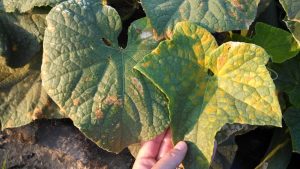Cucurbit downy mildew has been observed on cucumber and cantaloupe near Wanatah, in La Porte County, Indiana. Downy mildew has also been confirmed on cucumber in St. Joseph County Michigan, just northeast of Elkhart, Indiana as well as on processing pumpkin in central Illinois. Downy mildew of cucurbits has also been reported in southern and central Kentucky and north-central Ohio. All cucurbit growers in Indiana should be scouting and managing for downy mildew.
The organism that causes downy mildew of cucurbits doesn’t overwinter in Indiana. It has to be blown in every year. It is common for downy mildew to start the season in the Gulf States and migrate north with the cucurbit crops. Downy mildew apparently overwinters in northern Michigan/southern Ontario in greenhouses where cucumbers are grown year round. Therefore, downy mildew is often found in Michigan before it is found in Indiana.
Many cucumber varieties have some resistance to downy mildew. For susceptible cucumber varieties or other types of cucurbits, specialized systemic fungicides will help to reduce the severity of downy mildew. Unfortunately, many of the most effective systemic fungicides for downy mildew are not effective on our more common cucurbit diseases. This is because the organism that causes downy mildew, Pseudoperonospora cubensis, is not really a fungus at all. P. cubensis is more closely related to a brown algae. This fungus-like organism is related to the organism that causes Phytophthora blight (Phytophthora capsici). Therefore, many of the same fungicides that are effective against downy mildew are also effective against Phytophthora blight.
The Midwest Vegetable Production Guide for Commercial Growers lists several products that will help to slow the progress of downy mildew of cucurbits. Among the products listed as likely to be effective against downy mildew include: Forum®, Gavel®, Orondis Opti®, Orondis Gold®, Orondis Ultra®, Ranman®, Revus®, Zampro® and Zing®. Be sure to check the label for the re-entry interval, the pre-harvest interval, the FRAC group and other important information. Always alternate FRAC groups.
One other item of interest: Downy mildew of cucurbits is not caused by the same organism which causes downy mildew of soybeans. Therefore, downy mildew of soybeans will not spread to the pumpkin field immediately adjacent.
This article https://vegcropshotline.org/article/pumpkin-disease-management-steps/ has photos of downy mildew of pumpkin. Below, find a photo of downy mildew of cucumber. Note that the yellow lesions are scattered across the leaf, not concentrated on the edge of the leaf. As mentioned in the article linked above, under moist conditions the underside of the lesions will have the dark, fuzzy growth of the fungus-like organism that causes downy mildew.

Figure 1: Downy mildew of cucumber can be recognized by the yellow lesions scattered across the leaf. Downy mildew of cucurbits has been reported in Indiana.